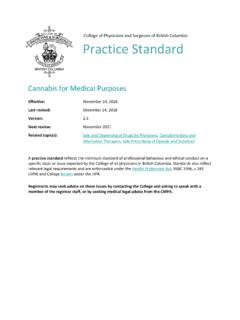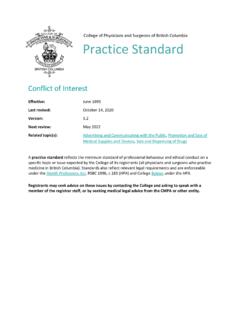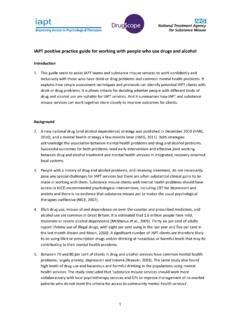Transcription of Practice Standard
1 Practice Standard College of Physicians and Surgeons of British Columbia Safe Prescribing of Opioids and Sedatives Effective: June 1, 2016 Last revised: December 10, 2018 Version: Next review: June 2021 Related topic(s): Prescribing Methadone A Practice Standard reflects the minimum Standard of professional behaviour and ethical conduct on a specific topic or issue expected by the College of all physicians in British Columbia. Standards also reflect relevant legal requirements and are enforceable under the Health Professions Act, RSBC 1996, (HPA) and College Bylaws under the HPA.
2 Registrants may seek advice on these issues by contacting the College and asking to speak with a member of the registrar staff, or by seeking medical legal advice from the CMPA. College of Physicians and Surgeons of British Columbia Practice Standard Safe Prescribing of Opioids and Sedatives 2 of 4 December 10, 2018 (Version ) PREAMBLE This document is a Practice Standard of the Board of the College of Physicians and Surgeons of British Columbia. COLLEGE S POSITION Opioids and sedative medications have high-risk profiles. Historically, prescribing these medications has contributed to the rise in people living with substance use disorder (SUD).
3 The profession has a collective ethical responsibility to mitigate its contribution to problematic prescription medication use, particularly the over-prescribing of opioids and sedatives. The fundamental purpose of this Standard is primary prevention of overdose, addiction, and other harms of the use of opioids and sedatives. Physicians are expected to follow the 2017 Canadian Guideline for Opioids for Chronic Non-Cancer Pain, which is complementary to, and should be read in conjunction with, this Standard . This Standard does not apply to active cancer care, palliative care, and management of substance use disorders .
4 Physicians are expected to follow relevant clinical guidelines and established best practices in managing patients with these conditions. Nothing in this Standard interferes with a physician s obligation to provide aggressive symptom management to patients with active cancer, or nearing the end of their lives. In the treatment of opioid use disorder (OUD), physicians are directed to follow accepted clinical guidelines and the Prescribing Methadone Practice Standard , when initiating and implementing opioid agonist treatment (OAT). It is incumbent on all physicians to have an approach to identify patients with these complex care needs, and to manage or refer these patients in a manner consistent with their training, scope of Practice , and location.
5 The high-risk medications covered by this Standard include opioids, benzodiazepines (including the Z-drugs zopiclone and zolpidem), and other sedative-hypnotics such as barbiturates. Long-term opioid treatment (LTOT) refers to the prescribing of opioid medications on a continuous daily schedule. STANDARDS 1. The CMA Code of Ethics and the College Standard Access to Medical Care prohibit discrimination based on medical condition and complexity. Physicians must not exclude or dismiss patients from their Practice based on their current use of, or request for, opioids or sedatives, or a suspicion of problematic use of prescription medications.
6 2. Physicians must base decisions to prescribe opioids and sedatives on a thorough understanding of their patient. This includes: a. Conducting and documenting a comprehensive assessment including patient history, physical examination, and relevant investigation results. b. Conducting a comprehensive reassessment at least every three months. c. Basing decisions to continue long-term treatment with opioids and sedatives on objective evidence of benefit. Continuing to prescribe only because these medications were previously prescribed is not acceptable. College of Physicians and Surgeons of British Columbia Practice Standard Safe Prescribing of Opioids and Sedatives 3 of 4 December 10, 2018 (Version ) 3.
7 When initiating treatment with an opioid or sedative medication, patients must be fully informed of the risks and benefits of such treatment. This includes holding and documenting a discussion about the rationale for a treatment regimen, expectations and goals of patient and physician, alternative treatment strategies, and a plan for the eventual possible discontinuation of the medication. 4. Physicians must use appropriate and available strategies to mitigate risk of harm when asked to prescribe or renew a prescription for opioid or sedative medications, including: a.
8 Reviewing patients medication profile, and consulting PharmaNet (if available) before prescribing the high-risk medication. This will prevent harmful drug interactions and combinations, and prevent patients from obtaining multiple prescriptions from multiple providers for the same medication. b. Considering random urine drug testing (rUDT) before initiating treatment, or as a baseline test for patients on long-term opioids and sedatives. Annual, or more frequent, rUDT and/or random pill counts must be considered for patients at risk of SUD, or if medication diversion is suspected.
9 C. Documenting their recommendation of take-home naloxone to all patients who are at risk of respiratory depression as a consequence of receiving opioid medications. 5. Patients must be advised about the dangers of taking opioid or sedative medications while performing safety-sensitive occupations, providing child or elder care, and driving. 6. When considering continuing LTOT physicians must document their discussion with patients that non-pharmacologic therapy and non-opioid analgesics are preferred for chronic non-cancer pain (CNCP), and that the potential benefit of LTOT is modest and the risk significant.
10 7. For patients on LTOT, physicians must always prescribe the lowest effective dose of opioid medication. a. Physicians must be confident, and document, that there is substantive evidence of exceptional need and benefit for doses >90 morphine equivalent daily dose (MEDD) of prescribed opioids. b. For all patients on LTOT, but particularly those on >90 MEDD, the merits of tapering to the lowest effective dose must be emphasized. Such tapers must be slow to minimize patient discomfort. Patients attempting a taper need supportive counselling and frequent follow-up.












